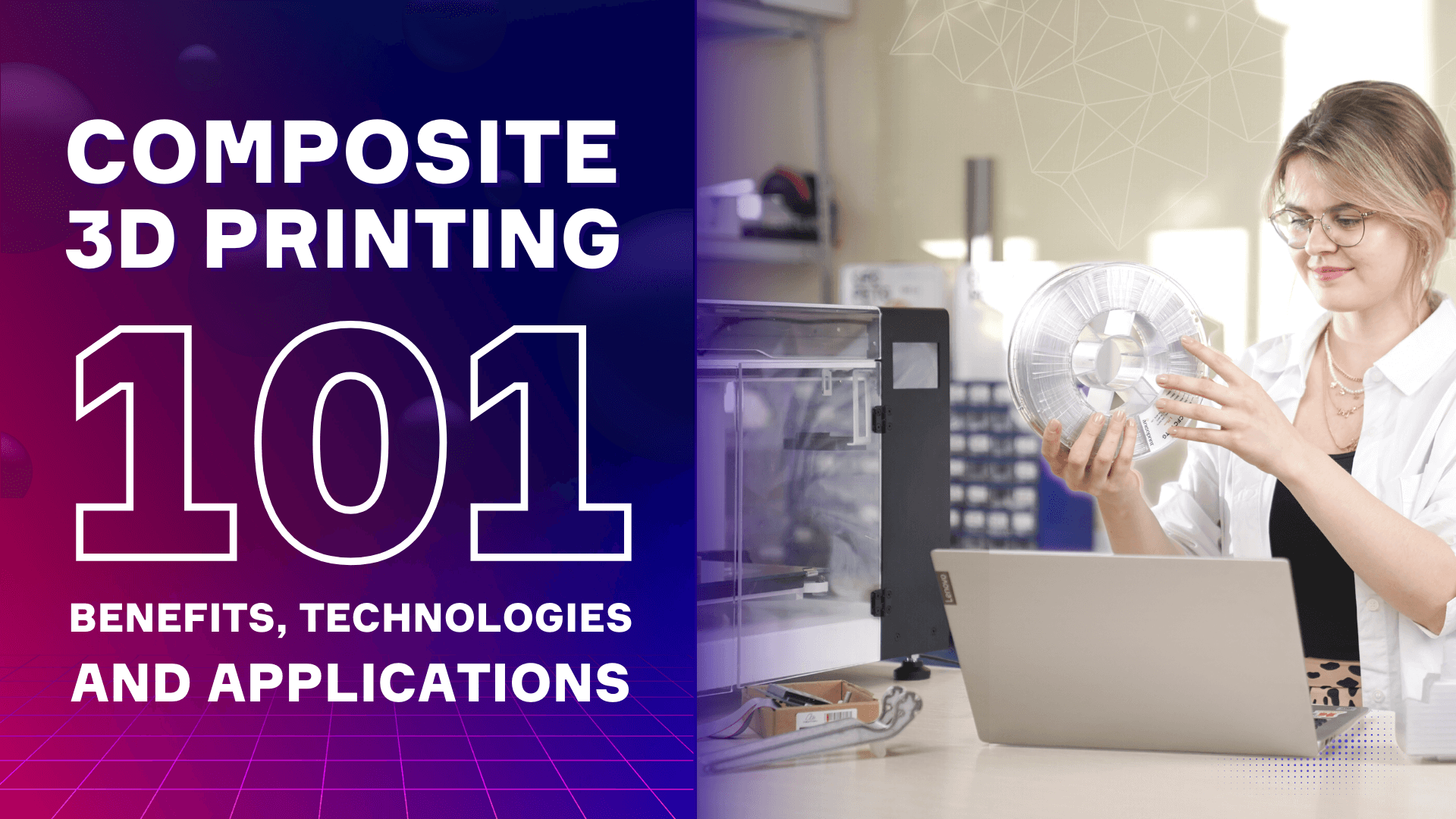
Within this overview, we will observe the benefits of composites in comparison with plastics and metals, look inside the existing composite 3D printing technologies, investigate the nowadays market and dwell on Anisoprinting.
Continuous carbon fiber reinforcement enhances mechanical properties of printed parts unlocking a wide range of applications in aerospace, automotive, aviation, and medical industries, and we will make a special case on it.
WHAT IS A COMPOSITE?
A composite material is any material consisting of two or more components with different properties and distinct boundaries between the components. When we speak about continuous fiber 3D printing, by composite we particularly mean fiber tows impregnated and covered by plastics. Typically, composites consist of a base polymer, referred to as a matrix, and reinforcing fiber of any type (carbon, basalt, glass, etc) bound together to produce a particular set of desirable resulting characteristics.
Whether filled with chopped or reinforced with continuous fibers, such materials feature improved parameters of stiffness and strength compared to pure plastics, though exhibit different anisotropic behavior. The interest in composite fiber 3D printing is accounted for by the fact that stiffness and strength parameters are by an order of magnitude greater than those of non-reinforced plastic; by contrast, chopped fiber filling at best only doubles this parameter for the resulting part.
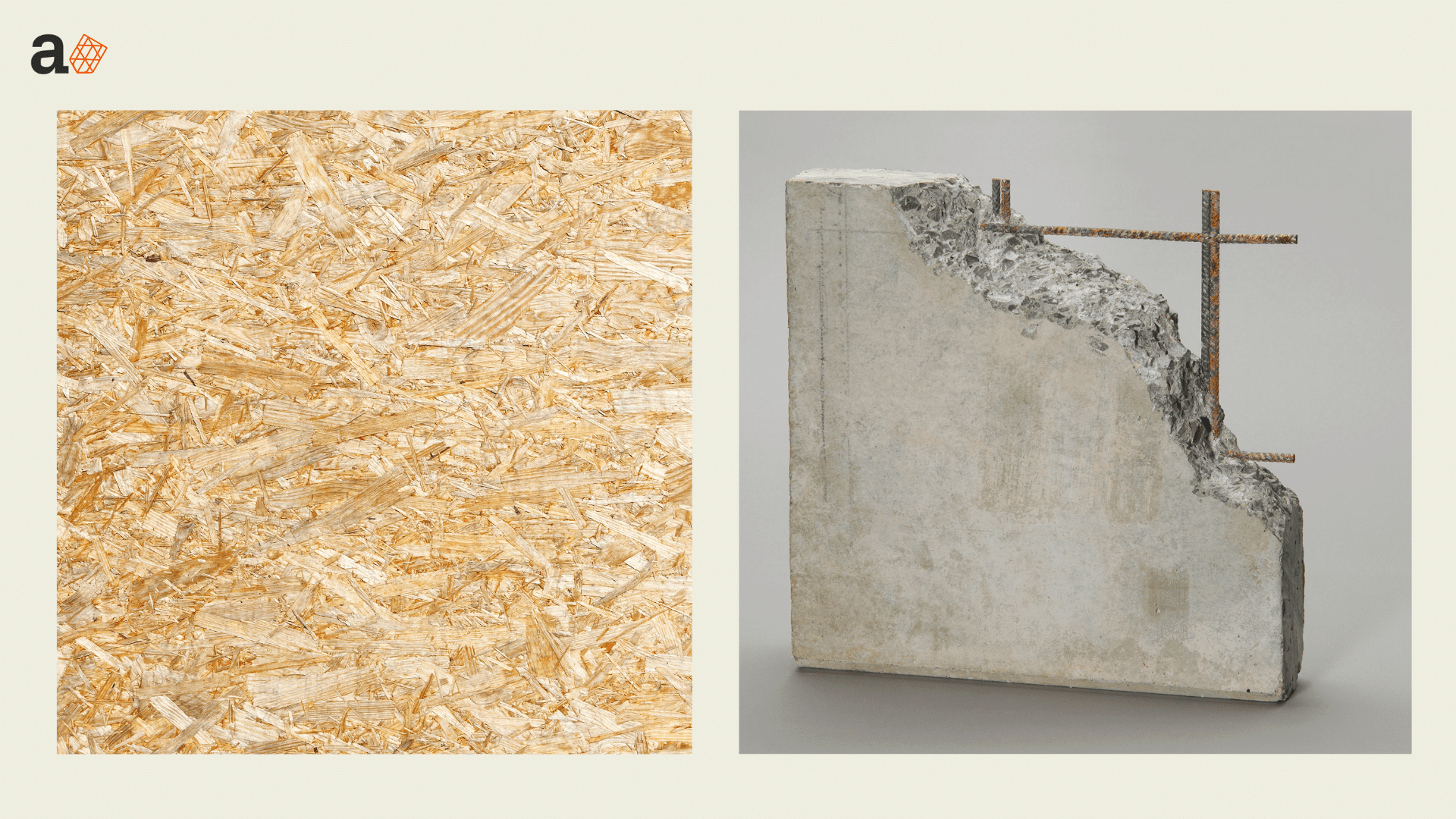
WHAT ARE THE BENEFITS OF COMPOSITE 3D PRINTING?
There exists a variety of methods to manufacture composite products, though many of them are costly, time-consuming, and labor-intensive. Unlike traditional ways with a manual layup of prepgregs or plies inside molds, composite 3D printing opens up an opportunity to automate the process. Once the parameters are set and the model is sliced (prepared for printing), it does all the work without any further effort.
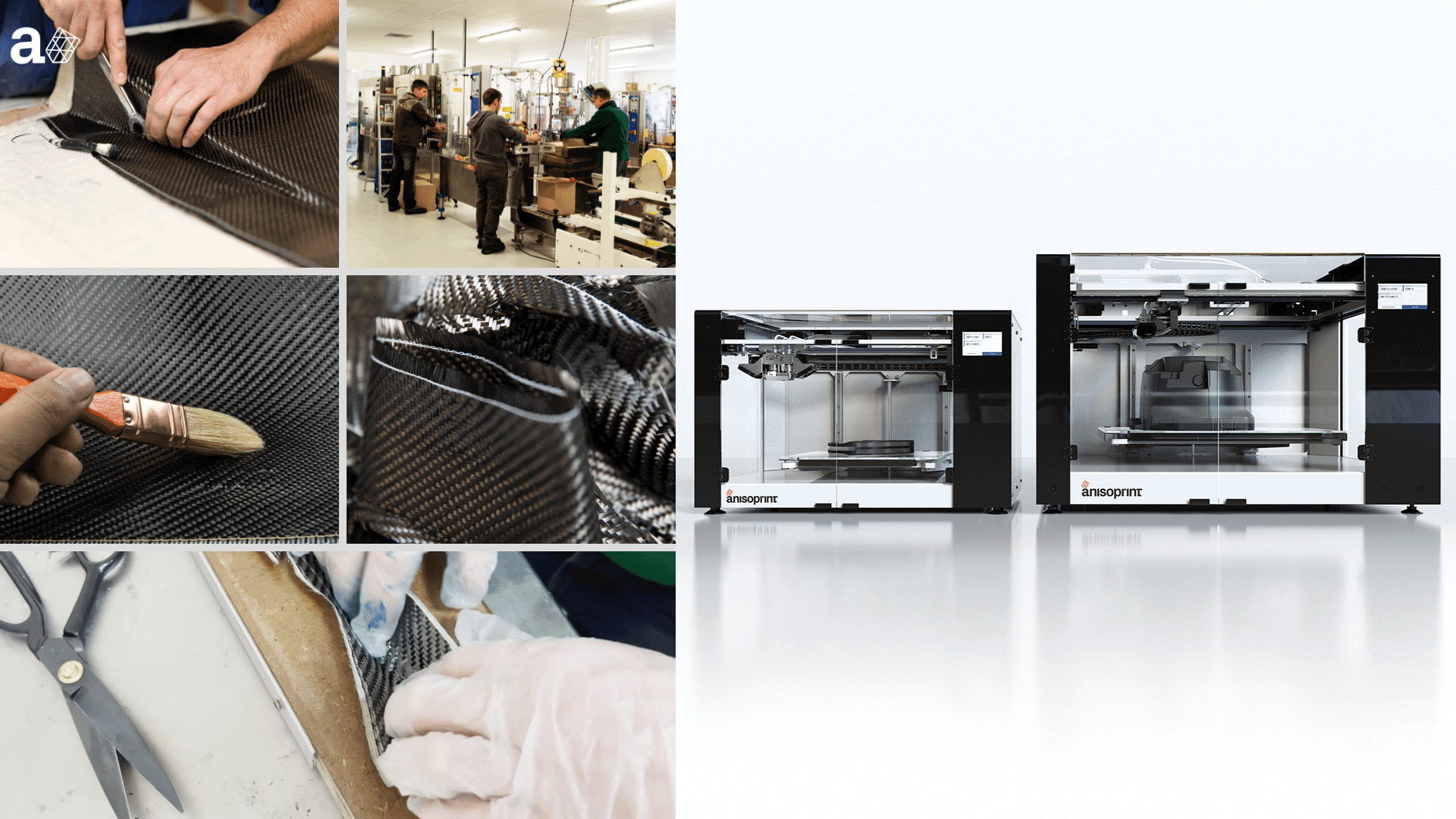
Fast prototyping and cost-saving
3d printed composite materials are strong, but at the same time very light. These key features – weight, strength, and design freedom, – pave the way for a number of industrial uses where battery, fuel, or speed counts.
As well we approach here the most prominent advantage of composite 3D printing — fast prototyping. Using CAD for creating a part, one goes from the design straight to manufacturing without the need to start a whole production line and simply adjust the models after the first prototype, without any extra costs or waste of material. This is critical for SMEs, as in small production runs of customizable parts it will drop the price for the end-user.

WHAT COMPOSITE 3D PRINTING TECHNOLOGIES EXIST ON THE MARKET TODAY?
By now, composite additive manufacturing market is only emerging. Even though the progress accelerates rapidly, there are only a handful of companies with ready solutions for composite 3D printing.
Most products feature a printing head with one or two nozzles: the head may be designed for fused filament fabrication, FFF (suitable for filaments from pure or carbon filled plastic), or have special construction for continuous fiber printing where it needs to operate with long fibers too. The head moves over the platform to build up parts layer by layer. FFF is used interchangeably with FDM (fused deposition modeling).
Continuous carbon fiber 3D printing technologies are collectively called CFF, or continuous filament fabrication.
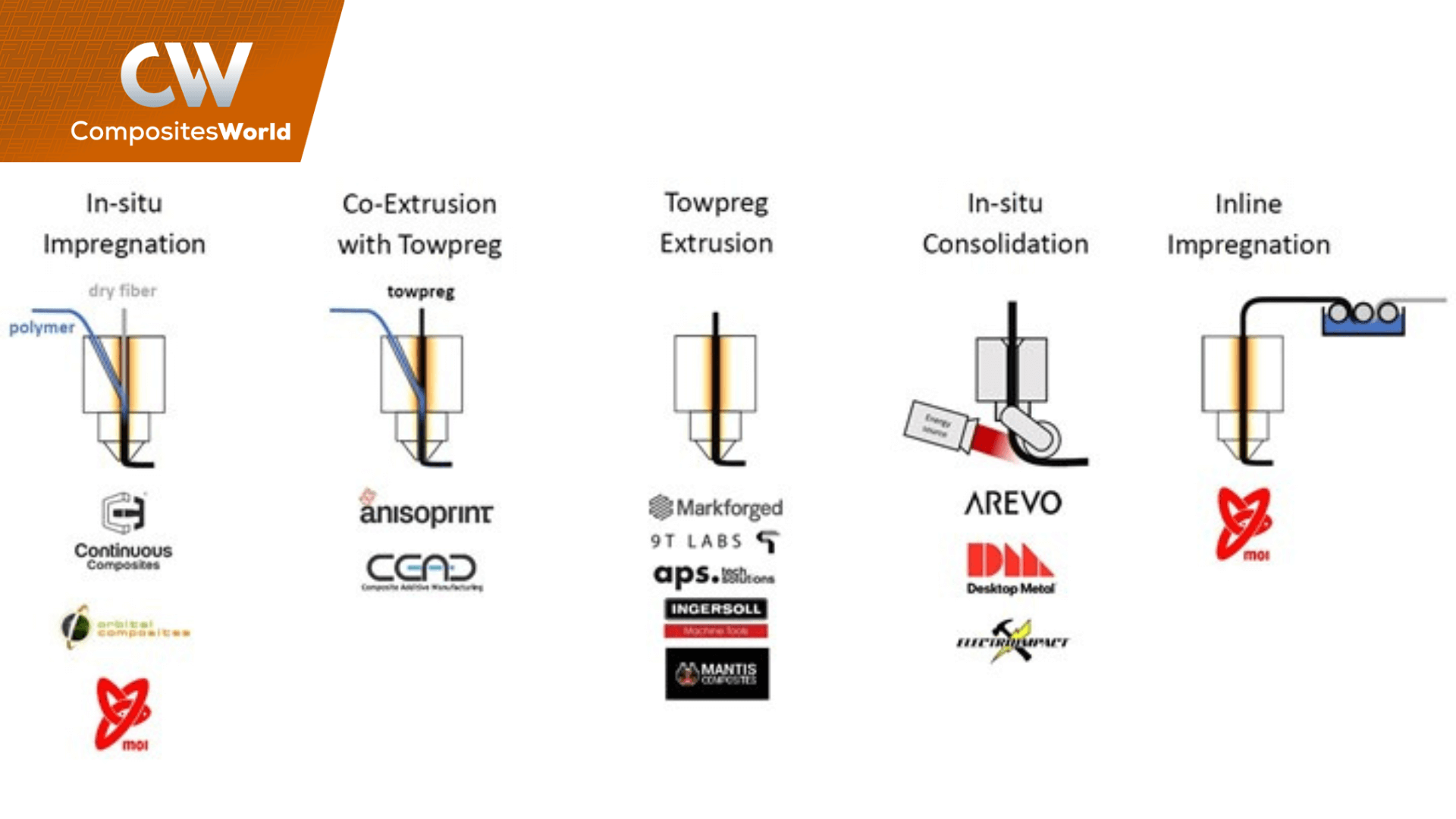
There are a couple of methods where dry fiber is impregnated with a thermoplastic either while it is transported into the print head or inside it — in-situ and inline impregnation respectively.
There are two more methods that make use of already prepared towpreg for extrusion, one as is, the other — in combination with a laser that heats the deposition area and a roller that presses the fiber in.
Another technology recently was introduced by Anisoprint: composite fiber coextrusion – CFC.
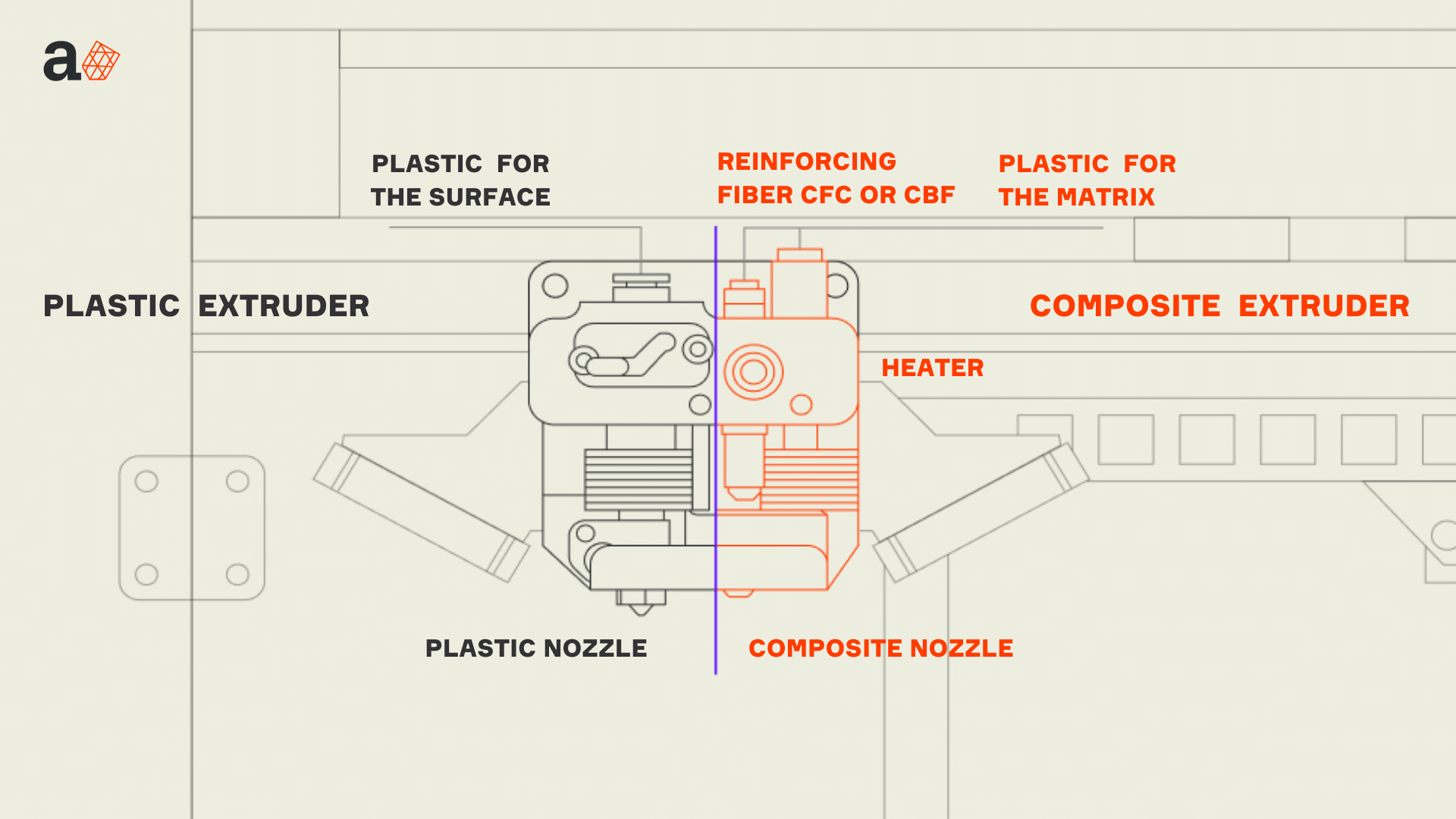
In CFC, the thermoset impregnated fiber and a plastic matrix are bound together at the moment of printing: it allows customizing the feed speed and varying fiber volume ratio.
As the matrix and the fiber are fed from separate spools and combined inside the printing head, users have freedom to choose both components as they like.
Options for customization are numerous in terms of part complexity, fiber fraction, and choice of the matrix material. CFC allows any type of polymer as a matrix, for instance, PETG, ABS, PC, PLA, and nylon, resulting in thermal or chemical resistance, impact, wear, fatigue resistance, or particular friction properties depending on the goal.
Fiber choice is also flexible: carbon for strength, basalt for radio transparency, or glass for saving costs.
See how СFC technology works in action, the Composer A4 print head:
WHAT IS ANISOPRINTING?
CFC technology offers the most flexibility for composite manufacturing. The core of Anisoprinting technology is adding a plastic to a towpreg at the time of printing. The towpreg here is carbon fiber pre-impregnated with a thermoset. There are several reasons for using thermoset: it is cheap, it is the industry standard, and most importantly, it does not allow pores between the single fibers in a bundle due to low viscosity while providing good adhesion — due to capillary effect, or wicking, it fills in all the spaces between fibrillas quickly and fully. This is a central issue for all composite products since pores as we see below are notorious for making the material brittle and give rise to a whole number of complex problems.
This sort of composite is referred to as bi-matrix, as the resulting part will contain two matrix materials: a thermoset and a thermoplastic. One works as impregnation, the other as a binder between the layers. In our case, the second plastic can be any, the choice of this plastic will be a marker of other properties (in addition to mechanical) for the future part, one can opt for non-flammable plastic, or different colors, resistant to heat or chemical impact.
Together with it we can, as we have a separate supply of fiber and plastic, at each point locally change the volume of fiber and plastic.
We can feed less plastic to increase the fiber volume, if we feed more plastic, it decreases. This way we control the degree of anisotropy and, more importantly, print lattice structures with fiber intersections within a single layer. That is, we can stack reinforcing fibers on top of each other, at any angle we need, within each layer individually. At the same time, the thickness of the layer at the intersection point is not growing; only the volume fraction of fibers in this very place changes.
WHAT ARE TYPICAL APPLICATIONS FOR COMPOSITE 3D PRINTING?
There are several reasons why CFC 3D printing is considered the most ergonomic and economically reasonable technology compared to both composite molding and metalwork:
- There is no waste, no post processing, and nearly no limit to shape complexity;
- The technology is fully automated, it is clean, compact, and saves human labor;
- Last but not least, there is a growing number of applications where composites outperform metals.
3D PRINTED AIRCRAFT SEAT SUPPORT
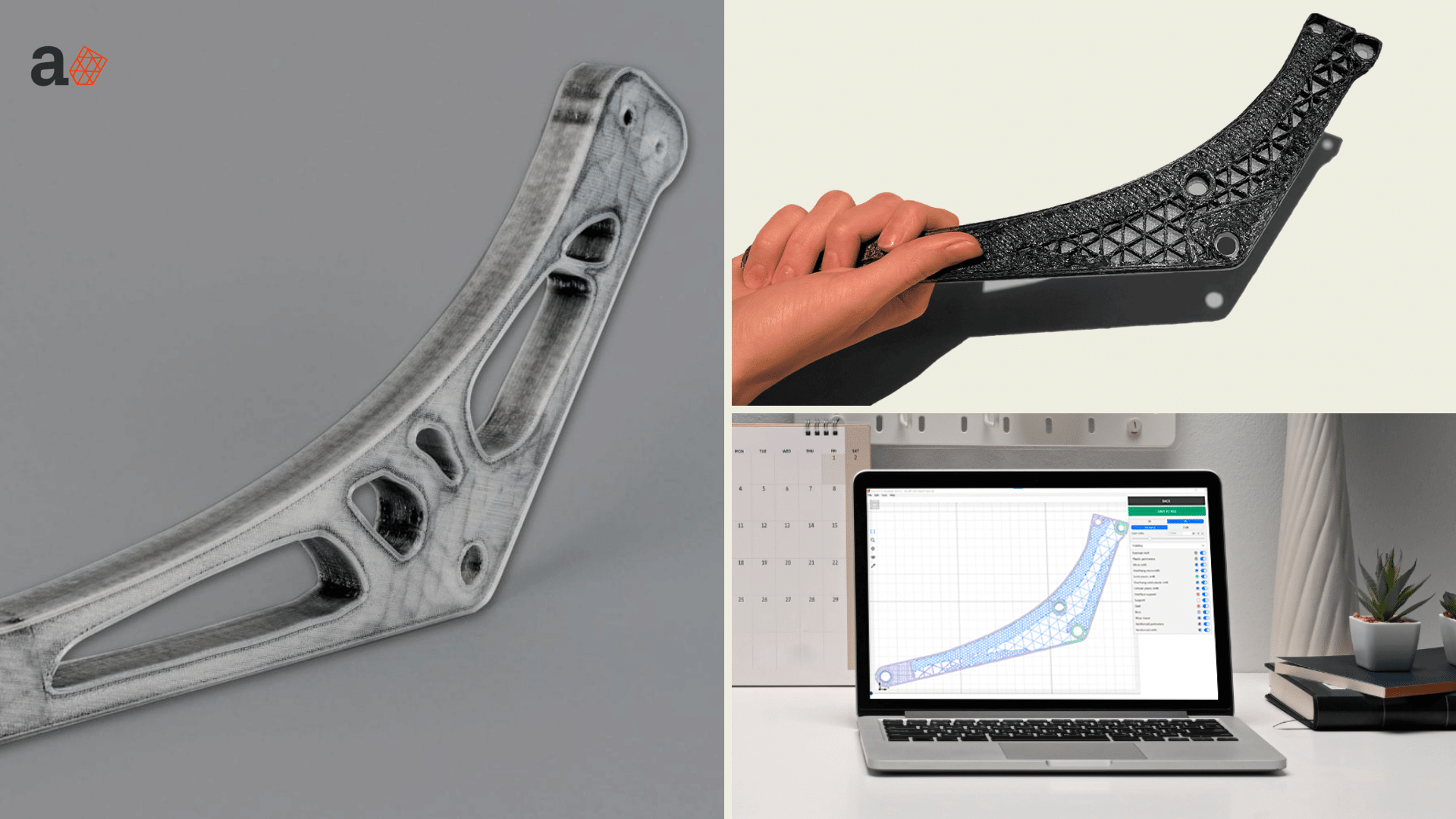
The first and most important parameter, light weight, makes composite parts a reliable substitution for metal ones in aircraft engineering. A lot of internal equipment like wall brackets, seat supports, and other constructional elements produce a substantial surplus mass when in bulk, thus adding extra expenditure and fuel consumption. Replaced by composite, such elements save 38% of the weight.
- Original part: 400 g.
- Anisoprinted part: 250 g.
DOWNHILL BIKE COMPOSITE ROCKER
Another application stems from effortless customization, where individual design is paramount. Here extra strong and light equipment tailored specifically for the user becomes affordable and easy to produce. Sportbikes parts design, wearable medical equipment, prototyping for narrow R&D areas, etc. have a broad horizon with 3D printed composites applications.
Let us look at a sportsbike suspension part. The composite rocker was printed on the Composer 3D printer, it exhibits the same performance as the metal one adding 40% material/cost savings, and is 35% lighter at the same time.
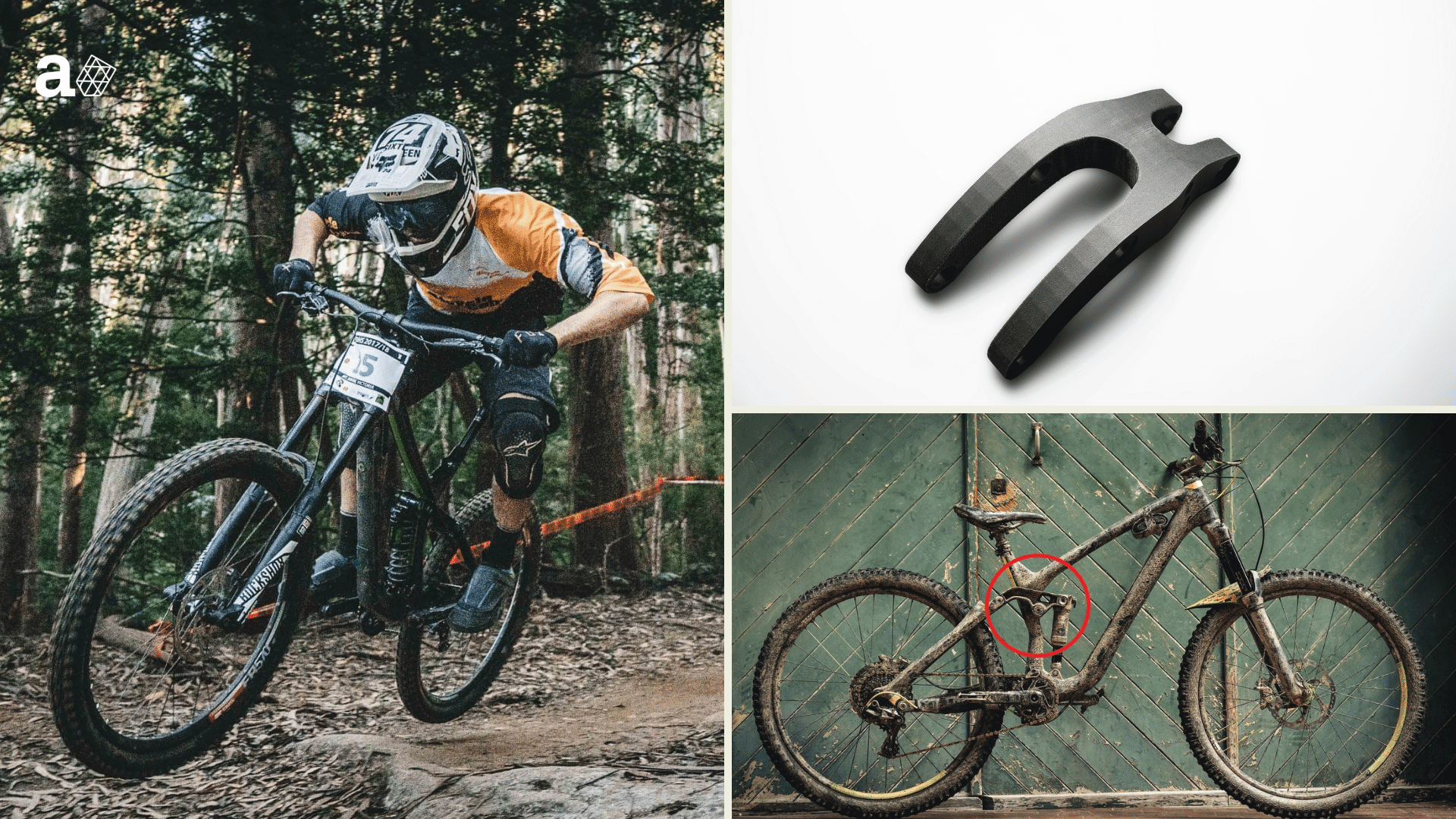
The rocker bears impact from flexural tension during the exploitation. As it is traditionally produced from metal, the guaranteed strength results in a high cost of manufacturing. Continuous fiber 3D printing removes this problem and reduces weight as a bonus.
- Original part: 500g, €380
- Anisoprinted part: 250g, €250
COMPOSITE MOLD FOR TURBINE BLADE PRODUCTION
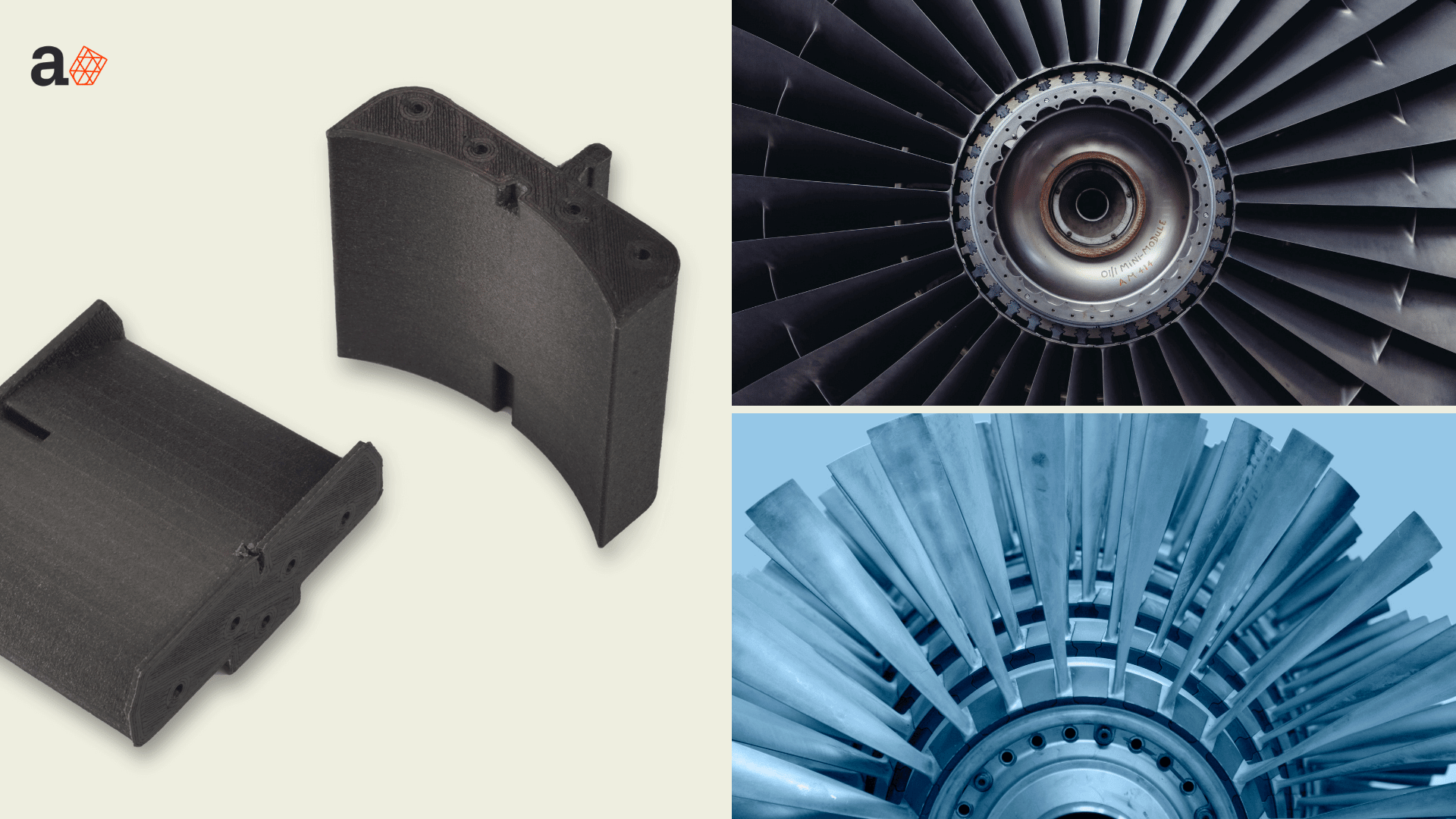
Another important example of ergonomic shape is designing blades that convert mechanical motion of a liquid or gas into kinetic energy. Applications are numerous: impellers, turbines, turbo pump units, fans, etc. There is a whole bunch of parameters to change and adjust — cross-section, thickness, inclination angle, even minor changes in shape are capable of changing performance in a significant way. Each iteration takes developing and creating a new metal stamp that gives shape to the new blade; here we offer an advantage in speed and design flexibility.
Faster and cheaper development and testing plus operation efficiency of the blades sum up and lead to both immediate and long-term benefits. Using composite 3D printing makes the tool 8 times lighter allowing to use cheaper equipment and saving power spent for operation. It sums up with a 40% cost reduction on material in comparison to metal parts of the same strength and performance under heavy-duty working conditions. Moreover, printing tools on the Composer 3D printer let control the production process, showing the exact TAT for a given part before the start.
- Original part: 31 kg, €200
- Anisoprinted part: 4 kg, €700
3D PRINTED DRONE FRAME
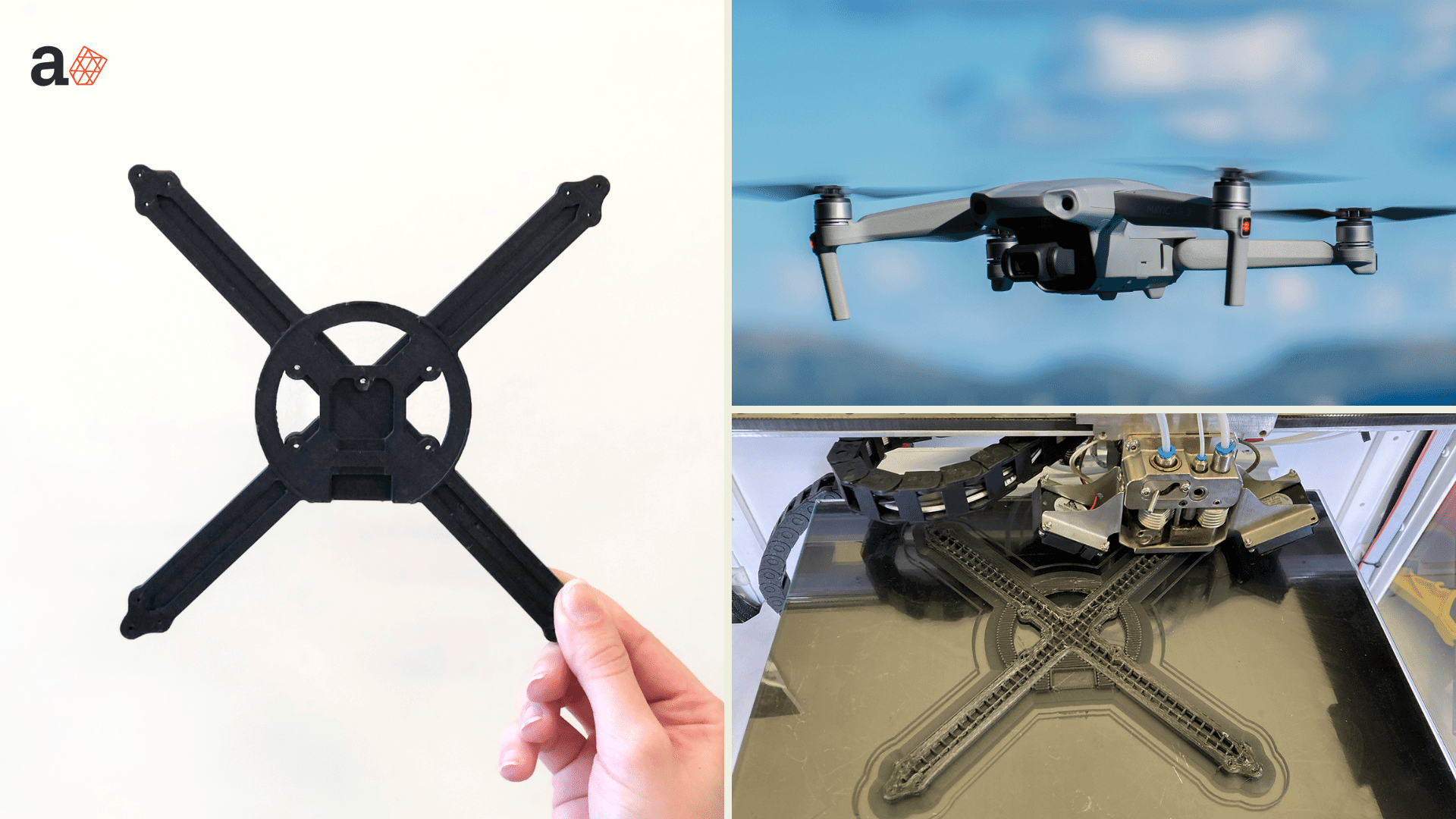
Airspace applications present the most illustrative examples of critical savings due to tight weight be it jet fuel or battery life. Composite materials drastically outperform metals for drones components: here is a story of anisoprinting a drone frame and making it 43% lighter, 48% cheaper, and achieving fundamental frequency of 200.3Hz.
- Original part: 32 g, $60
- Anisoprinted part: 18 g, $31
SUSPENSION PARTS FOR A LUNAR ROVER
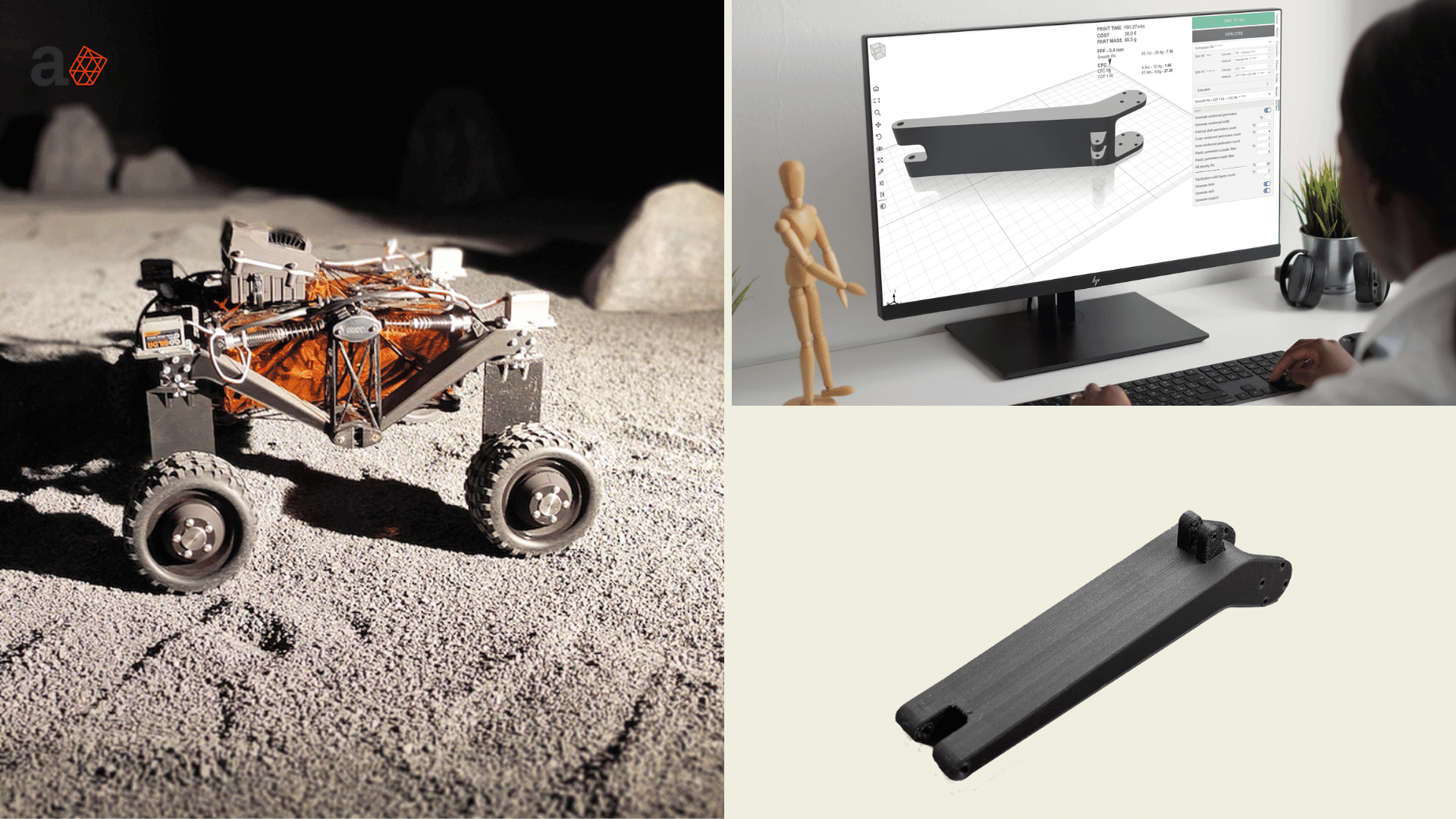
Space vehicles components (like for this lunar rover) are under even greater pressure in terms of light weight and complicated logistics: composite 3D printing not only produces reliable custom components in situ and on demand, but also saves human labor and produces zero waste. For this project, we remodeled two suspension parts – a wheel mount and control arm – and changed the geometry to cut out the areas that are not loaded. This is our space success story.
- Original part: 105 g
- Anisoprinted part: 64 g
That’s it! You have some unanswered questions? Fill in the form below and we’ll get back to you!
[hubspot type=”form” portal=”25897477″ id=”74952842-0877-4fd8-9c76-a728c5860746″]